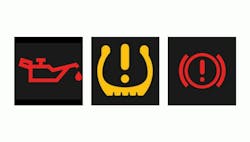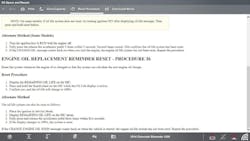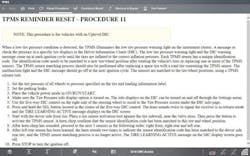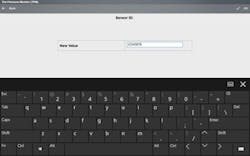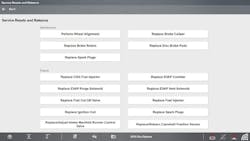Unlocking vehicle maintenance and why scan tools are now non-negotiable
Most vehicles need a scan tool to perform even the simplest of maintenance functions like oil reminder resets, placing the parking brake into service mode, battery resets and TPMS resets, to name a few.
In this article, we will look at how a scan tool is an integral part of the process to ensure you can remain productive in the bay.
Why do you need a scan tool?
Modern vehicles are heavily reliant on computer-controlled systems. What used to be simple jobs, such as oil changes, brake pad replacements or battery swaps, now involve electronic systems that require resetting, calibrating or reprogramming. For example, oil life monitors must be reset, electronic parking brakes need to be placed into service mode, new batteries have to be registered with the ECU and steering angle sensors often require recalibration after alignment.
Professional scan tools allow technicians to perform these essential steps quickly and accurately, ensuring the vehicle’s systems continue to function properly. Without it, maintenance may be incomplete, warning lights may stay on and the risk of premature wear or costly repairs increases.
Oil and filter service
How scan tools simplify oil and filter maintenance
Every vehicle model and manufacturer has varying types of oil and quantities that are recommended by the OEM. Ensuring the right oil and the correct amount is used ensures that the engine and all its components run smoothly. We have all seen vehicles with the black plume of smoke, which are running on the wrong oil, let alone those broken-down vehicles that have no oil at all, and have burnt out a costly engine.
- Tasks: replace oil and filter, reset oil-life monitor, inspect for leaks
- Diagnostic tool use:
- Using the Quick Lookup menu on a Snap-on® diagnostic tool allows you to check the oil specification for the vehicle you are working on without leaving the fender
- Reset the oil monitor through the scan tool
- Scan for stored codes (misfire, fuel trim, oil pressure) — some can be early indicators of lubrication issues
A lack of regular oil changes is also the most common cause of timing chain elongation. We cover this in detail in our technical focus article: Timing Chain Replacement: Are Timing Chains Still Causing Headaches?
Tire and wheels
Why TPMS servicing is essential in every shop
A tire-pressure monitoring system (TPMS) is an electronic safety system designed to track the air pressure of pneumatic tires and alert the driver when pressure falls below safe levels. Depending on vehicle design, the alert may appear as:
- A dedicated dashboard warning light
- A pictogram or digital display showing real-time values
- An integrated instrument cluster warning
For technicians, TPMS servicing is no longer optional; it’s an essential shop capability. To dive deeper into best practices and common challenges, check out our technical focus article on Tire Pressure Monitoring System – The Virtual Tire Kick.
- Tasks: rotate, balance, check tread, TPMS, sensors
- Diagnostic tool use:
- Testing faulty, dead, or weak sensors
- Access systems through Secure Gateways
- Using Quick Lookups on a Snap-on diagnostic tool allows you to check the correct tire pressure values
- Scan and relearn TPMS sensors after rotation/replacement
- Some tools can show sensor battery life and signal strength
For a step-by-step demonstration, see our Quick Tip on wheel and tire calibration on a Chrysler.
Battery functions
Mastering battery management system (BMS) service with a scan tool
Some manufacturers use a battery management system (BMS). BMS uses sensors, controllers and software to monitor the battery state of charge. This allows the vehicle to charge the battery depending on load and state of health. When a battery is replaced, the system needs to be reset – usually with a scan tool.
- Tasks: test battery, replace battery, inspect terminals, check charging system
- Diagnostic scan tool use:
- Run a battery health test
- Reset battery registration after replacement
- Scan for stored low-voltage codes that may indicate charging issues
Find more detailed guidance:
- Learn more about battery relearn procedures in our technical focus article on Automotive Networks Part II: Controller Area Network Bus.
- Watch our step-by-step video on Battery Registration for practical demonstrations.
Brake system maintenance
Brake diagnostics and EPB service with a scan tool
Modern vehicles often require the use of a scan tool to place electronic parking brakes into service mode or to reset ABS-related functions after repairs. Keeping the brake system maintained not only prevents breakdowns, but also ensures the driver can rely on maximum stopping performance when it matters most.
- Tasks: inspect pads, rotors, callipers, and brake fluid
- Diagnostic tool use:
- Use the scan tool to put electronic parking brakes (EPB) into service mode before pad replacement.
- Check ABS codes and live data (wheel speed sensors, brake pressure sensors). For a deeper dive, read our article on Anti-lock Braking System (ABS) -- Stop, in the Name of Safety.
- Pro Tip: Watch our Quick Tip video on brake pedal position sensor relearn for a step-by-step demonstration.
In today’s automotive industry, vehicle maintenance goes far beyond changing fluids and replacing worn parts. With nearly every system tied into onboard computers, a professional scan tool has become just as essential as a wrench or socket. From resetting service indicators and registering new batteries to calibrating steering sensors and servicing electronic parking brakes, scan tools ensure maintenance is done correctly, efficiently, and to manufacturer standards. For technicians, this not only prevents costly comebacks, but also builds trust with customers by providing accurate diagnostics and proof of work.
If you’re ready to take your maintenance capabilities to the next level, explore the full range of diagnostic platforms that Snap-on has to offer by taking the Tool Matcher Quiz.
For more on this topic, click here.
About the Author
Phil Cooper
Phil Cooper is a Snap-on Diagnostic National Trainer.

